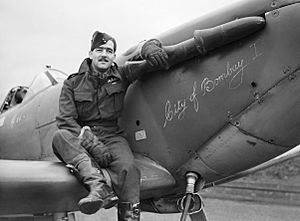No. 122 Squadron RAF facts for kids
Quick facts for kids No. 122 (Bombay) Squadron RAF |
|
|---|---|
| Active | 1 Jan 1918–20 Nov 1918 1 May 1941–1 Apr 1946 |
| Country | |
| Branch | |
| Nickname(s) | Bombay |
| Motto(s) | Latin: Victuri volamus ("We fly to conquer") |
| Insignia | |
| Squadron Badge heraldry | In front of a mullet a Leopard rampant. The mullet represents fighting in the heavens and the Leopard, a fierce fighter represents Bombay |
No. 122 (Bombay) Squadron was a special group of fighter pilots in the Royal Air Force (RAF). They flew planes during both the First and Second World Wars.
Contents
History of No. 122 (Bombay) Squadron

Early Days: World War I
The squadron first started on January 1, 1918, at Sedgeford. They were meant to fly Airco DH.4 planes for bombing missions. But they disbanded (closed down) on August 17, 1918, before they could fly any missions.
It was started again in October 1918 at RAF Upper Heyford, planning to use de Havilland DH.10 planes. But World War I ended very soon after (on November 11, 1918), so the squadron closed down again on November 20, 1918, without flying any missions.
World War II Missions
No. 122 Squadron started for the third time in 1941 at RAF Turnhouse. They flew Supermarine Spitfire planes to protect ships in the Firth of Forth. Soon, they moved to England and joined the Hornchurch Wing. Here, they flew Spitfires with cannons. They flew missions over northern France and helped in the Dieppe raid operations.
In 1942, František Fajtl became the squadron commander. He was the first Czech pilot to lead an RAF squadron! In October 1942, they got new Spitfire IX planes and kept flying missions over France.
Long-Range Flights and D-Day
In January 1944, the squadron switched to North American Mustang planes. These planes could fly very long distances. They were used to escort (protect) bombers on their missions. They also attacked targets in France and the Low Countries (like Belgium and the Netherlands).
A few months later, their Mustangs were changed into "fighter-bombers." This meant they could fight other planes and also drop bombs on targets on the ground. The squadron then flew long-range ground-attack missions into Europe. Under the command of Squadron Leader Ernest Joyce, they played a big part in the D-Day operations. Just a few weeks later, they moved to France to help support the invasion.
After three months of intense flying, the squadron returned to England. They continued to provide long-range protection for both the British Bomber Command and the American Eighth Air Force until the war ended.
After the War
After World War II, the squadron received new Spitfire F21 planes. However, No. 122 Squadron was disbanded (closed down) on April 1, 1946, at RAF Dalcross. Its number was then given to No. 41 Squadron.
Aircraft Operated by No. 122 Squadron
This table shows the different types of planes No. 122 Squadron flew:
| Dates | Aircraft | Variant | Notes |
|---|---|---|---|
| 1941 | Supermarine Spitfire | I | |
| 1941–1942 | Supermarine Spitfire | IIA and IIB | |
| 1941–1942 1943 |
Supermarine Spitfire | VB | |
| 1942–1943 1943–1944 1945–1946 |
Supermarine Spitfire | IX | |
| 1944–1945 | North American Mustang | III | |
| 1945 | North American Mustang | IV | |
| 1946 | Supermarine Spitfire | F21 |

